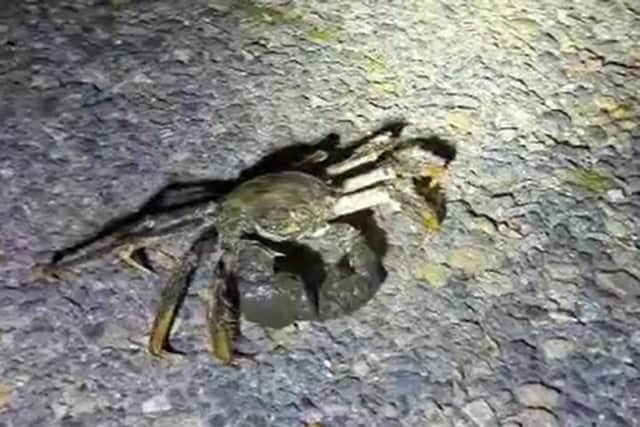Chinese mitten crab UK: can you eat them, are they edible, Peterborough sighting - why are they hairy?
and live on Freeview channel 276
A road close to a city was recently visited by an invasive species of crab that can "give a nasty nip" and is encroaching on Britain's inland waterways.
Locals in Peterborough, Cambridgeshire, spotted the Chinese mitten crab - which measured about 10 inches long - earlier this week (10 October) close to a rowing lake.
Advertisement
Hide AdAdvertisement
Hide AdThe green-grey crustaceans, which have thick 'fur' around their white-tipped claws, have been found throughout continental Europe and have wreaked ecological havoc in Germany. Here is everything you need to know about them.
What are Chinese mitten crabs?
Chinese mitten crabs, also known as Eriocheir sinensis, are a species of freshwater crab native to eastern Asia, particularly China. They are known for their distinctive appearance, with a furry, or "mitten-like," patch of setae (hair) on their claws, which gives them their name.
These hairs serve a number of purposes, including as sensory organs, an improved grip on surfaces, camouflage, and protection from predators.
The crabs are found in rivers, estuaries and coastal waters in China and some neighbouring countries, and are known to migrate between freshwater and saltwater environments during their life cycle to reproduce.
Advertisement
Hide AdAdvertisement
Hide AdChinese mitten crabs were likely introduced to the UK as hitchhikers on ships, and it's believed that they were first detected in the River Thames in the early 20th century.
The primary mode of introduction was likely through ballast water from ships travelling between the UK and China. Chinese mitten crabs have a planktonic larval stage, and when ships take on ballast water in one location and discharge it in another, they can unintentionally transport these larvae.
Are they dangerous?


Chinese mitten crabs are not considered dangerous to humans in the sense of being a physical threat, and do not pose a direct danger to people.
However, crabs from polluted or contaminated waters can carry health risks due to the potential accumulation of pollutants, heavy metals and contaminants in their bodies.
Advertisement
Hide AdAdvertisement
Hide AdLike many other species of crabs, Chinese mitten crabs are equipped with claws, and can give humans a "nip" if they feel threatened or provoked.
While the nip of a Chinese mitten crab is not known to be particularly powerful - it may pinch and might cause slight discomfort or a minor injury, but is unlikely to cause any serious harm - it's advisable to treat the crabs with care and avoid provoking or handling them.
Following the sighting at Peterborough's Ferry Meadows Country Park, officials warned locals about the crabs' “nasty nip”, saying: "They don’t pose any threat to people or dogs but would probably give a nasty nip with their pincers if anything gets too close, so we would advise visitors to keep their distance.”
Why are they an invasive species?
Chinese mitten crabs are considered an invasive species in the UK for several reasons.
Advertisement
Hide AdAdvertisement
Hide AdThey are burrowing animals, and their burrowing activities can weaken riverbanks and structures, leading to erosion and potential damage to infrastructure like levees. This can increase the risk of flooding and the costs associated with riverbank maintenance.
Mitten crabs compete with native species for food resources and habitat, potentially outcompeting and displacing native aquatic species. This competition can disrupt local ecosystems and threaten the survival of native species.
There have also been concerns about the spread of diseases or parasites associated with mitten crabs, which can affect both aquatic species and, in some cases, humans who consume contaminated seafood.
Are they safe to eat?
In some regions of Asia, Chinese mitten crabs are harvested for food. They are considered a delicacy in some Chinese cuisine and are often consumed during specific seasons.
Advertisement
Hide AdAdvertisement
Hide AdThey are often prepared in various dishes, such as crab soup, dumplings or stir-fries. However, as with any seafood, it's important to ensure that they are harvested from clean and uncontaminated waters and properly prepared to minimise health risks.
The safety of mitten crabs, or any seafood, can be influenced by factors such as water quality and potential contaminants in their habitat, and there have been concerns about the potential health risks associated with consuming Chinese mitten crabs from UK waters, given the contaminants and pollutants in some areas.
The Department for Environment, Food and Rural Affairs (Defra) says: "‘In the UK, there is no legal fishery for the species; if a Chinese mitten crab is caught as a by-catch, they cannot be sold live for human consumption."
What should I do if I spot a Chinese mitten crab?
If you see a Chinese mitten crab or happen to catch one, it's important to take appropriate action to help manage and control the spread of the invasive species.
Advertisement
Hide AdAdvertisement
Hide AdUnder no circumstances should you release the mitten crab back into the water, as this can contribute to their spread and potential ecological disruption.
Report your mitten crab sighting to the Environment Agency or a similar environmental agency responsible for managing invasive species and water quality. They will use this information to track the distribution and behaviour of mitten crabs.
When reporting the sighting, try to provide as much information as possible, including the location, date, and any photographs or descriptions of the crab. The more information you can provide, the better authorities can respond and manage the situation.
If you are involved in recreational or professional fishing, take precautions to prevent the accidental spread of mitten crabs to new locations, such as cleaning and disinfecting gear, checking for hitchhiking crabs and following guidance from local authorities.
Comment Guidelines
National World encourages reader discussion on our stories. User feedback, insights and back-and-forth exchanges add a rich layer of context to reporting. Please review our Community Guidelines before commenting.
